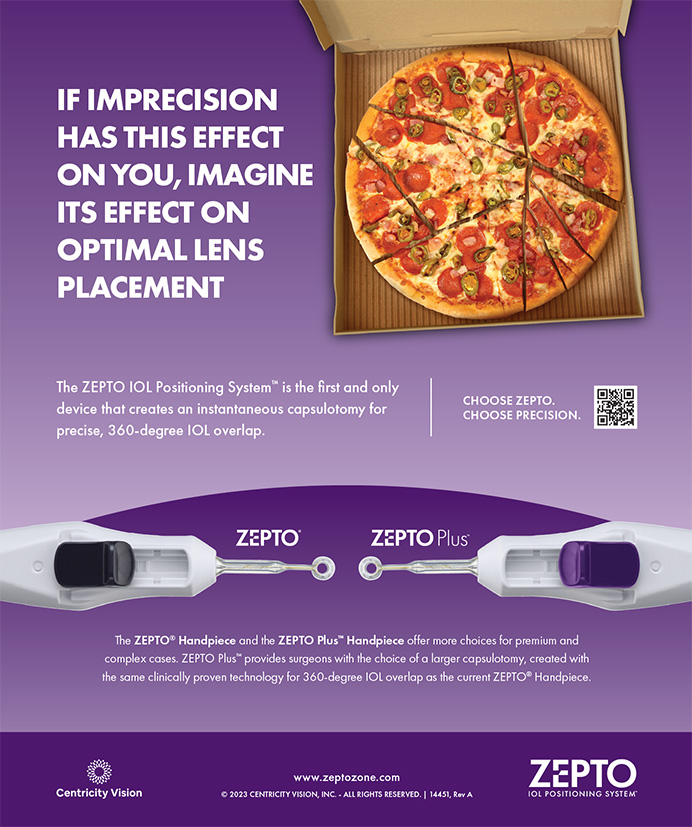ROBERT H. OSHER, MD
When Triesence (triamcinolone acetonide injectable suspension) 40 mg/mL (Alcon Laboratories, Inc., Fort Worth, TX) was first approved by the FDA, I was fortunate to investigate its capability for visualizing vitreous in a cadaver eye study designed to enhance surgeons' understanding of the dropped nucleus (Figure 1). My colleagues and I deliberately tore the posterior capsule and tested multiple hypotheses by using Triesence in order to determine the role of the vitreous. The results of the study were quite astonishing (RHO, unpublished data, 2008), and the video was awarded prizes at the ASCRS, ESCRS, and AAO 2008 annual meetings. I believe the study would have been much less revealing, however, had we not been so lucky to obtain the Triesence from Alcon Laboratories, Inc.
Vitreous staining in the anterior segment is not new. In fact, Scott Burk, MD, PhD, one of my previous fellows and a current associate, published the concept in 2003.1 Subsequently, he and his wife, Andrea Da Mata, MD, produced an award-winning video in the ASCRS film competition that also appears in the Video Journal of Cataract Surgery.2 The major advantage of Triesence is that the triamcinolone acetonide is not preserved, which makes it safer in the eye. The suspension can also be prepared quickly should the surgeon encounter an unexpected complication involving vitreous. It is my early opinion that Triesence will become a useful aid to anterior segment surgery.
LISA BROTHERS ARBISSER, MD
During complicated cataract surgery, or when an anterior vitrectomy is planned in a complex case, vitreous can be a challenge to visualize and therefore to remove properly. Our key goal in these cases is to minimize intraoperative and postoperative traction on the vitreous. Although there is a host of remote signs of vitreous loss such as a peaked pupil and poorly sealing incisions, we now have a valuable tool to assist us in providing the best outcomes for these challenging surgical adventures.
Suggested by Gholam Peyman, MD, for posterior segment surgery and popularized by Dr. Burk for the anterior segment, the particulate identification of prolapsed vitreous with triamcinolone acetate suspension has proven highly effective. The commercially available preparation, Kenalog (Bristol-Myers Squibb Co., Princeton, NJ) is only provided in a preserved vehicle, which works well for the posterior segment. Because the preservatives are not endothelium-friendly, however, Dr. Burk worked out a method to "wash" the Kenalog and resuspend it in balanced salt solution by using filter needles.1
Triesence is a time saver and ever at the ready without any preservatives and without the chemical, which may also have toxic potential, that keeps Kenalog dispersed in the suspension. Triesence need not be washed. Like Kenalog, it can be irrigated into the anterior chamber when the surgeon suspects prolapsed vitreous with the effect of throwing a sheet over a ghost; it allows the surgeon to visualize the vitreous. Both products have a beneficial anti-inflammatory therapeutic effect during the postoperative period in addition to their intraoperative diagnostic use. Triesence, which tends to clump more than Kenalog, is best diluted 10 or 15 to one in balanced salt solution. This dilution allows the particles to be individually trapped in the vitreous matrix without a white-out effect, which makes it hard to see the intraocular structures. Like Kenalog, Triesence will rinse out of aqueous and not adhere to viscoelastic but will stick to the vitreous. That allows a critical visual endpoint for anterior vitrectomy and reduces the likelihood that the surgeon will see a strand of vitreous to the incision (an unwanted surprise) at the slit lamp during the postoperative examination.
TODD GOTHARD, MD
I have used Triesence on a number of complex anterior segment cases, and I have found it useful in the determination of both whether vitreous was present in the anterior chamber and when the vitreous was completely cleared during vitrectomy. The suspension can be reinjected several times to help the surgeon ensure vitreal clearance or monitor progress during vitrectomy.
I have found Triesence extremely useful during cases of Descemet's stripping automated endothelial keratoplasty that have positive pressure. I use the solution to determine if vitreous has come forward through a capsulotomy or around the lens.
The cornea is usually edematous in Descemet's stripping automated endothelial keratoplasty cases, and Triesence can facilitate visualization of the vitreous, even with a cloudy cornea.
I use this suspension routinely for all complicated refractive lens exchange procedures that require a vitrectomy. This dye takes the guesswork out of these cases and eliminates the possibility of residual postoperative vitreal strands. Using Triesence is much more convenient than having to filter other commercial preparations and worry about residual preservatives and possible toxic anterior segment syndrome.
Section editors Robert J. Cionni, MD, and Michael E. Snyder, MD, are cataract specialists at the Cincinnati Eye Institute in Ohio.
Robert H. Osher, MD, is Professor of Ophthalmology, University of Cincinnati College of Medicine, and is Medical Director Emeritus, Cincinnati Eye Institute. He is a consultant to Alcon Laboratories, Inc. Dr. Osher may be reached at (513) 984-5133; rhosher@cincinnatieye.com.
Lisa Brothers Arbisser, MD, is in private practice with Eye Surgeons Assoc. PC in Davenport, Iowa, and she is Clinical Adjunct Associate Professor at the John A. Moran Eye Center, University of Utah, Salt Lake City. She has received honoraria and research grants from Alcon Laboratories, Inc., but stated that she holds no direct financial interest in the products mentioned herein. Dr. Arbisser may be reached at (563) 323-2020; drlisa@arbisser.com.
Todd Gothard, MD, specializes in cornea, cataract, and refractive surgery. Dr. Gothard is in private group practice with the Wolfe Eye Clinic in Cedar Rapids, Iowa. He acknowledged no financial interest in the products or companies mentioned herein. Dr. Gothard may be reached at (319) 362-8032; tgothard1@wolfeclinic.com.


